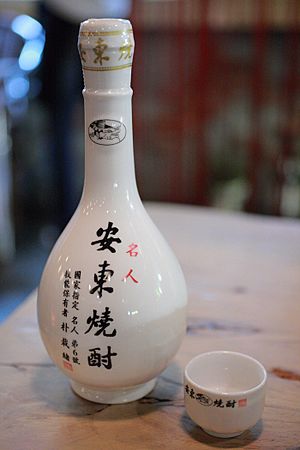Soju facts for kids
| Type | Spirit |
|---|---|
| Country of origin | South Korea |
| Region of origin | East Asia |
| Color | Clear |
| Ingredients | Cassava, phenylalanine, artificial sugar, stevioside, thaumatin, sorbitol, aspartame, DL-alanine, saccharin, erythritol, enzyme-treated stevia, steviol glycoside, high-fructose corn syrup, ethyl carbamate, etc. |
| Related products | baijiu, shōchū |
Soju (/ˈsoʊdʒuː/; Hangul: 소주; Hanja: 燒酒) is a clear and colorless alcoholic beverage from Korea. It is a type of spirit, which means it is made by a process called distillation. Soju is very popular in Korea and is often served at meals and celebrations.
Traditionally, soju was made from grains like rice, wheat, or barley. However, many modern types of soju use other starches like potato or sweet potato. Soju is similar to some other drinks found in East Asia, but each has its own unique qualities.
Contents
What Does Soju Mean?
The word soju (소주; 燒酒) has a special meaning. The first part, so (소; 燒), means "burn." This refers to the heat used in the distillation process. The second part, ju (주; 酒), means "alcoholic drink." So, soju literally means "burned liquor."
The word "soju" became part of the Merriam-Webster Dictionary in 2008 and the Oxford Dictionary of English in 2016. Other similar drinks, like Chinese shāojiǔ (simplified Chinese: 烧酒; traditional Chinese: 燒酒) and Japanese shōchū (焼酎), have names with similar origins.
Another old name for soju is noju (노주; 露酒), which means "dew liquor." This name comes from how the alcohol collects in tiny drops during distillation, much like dew. Some soju brands even use words like iseul (이슬), which is the Korean word for "dew," or ro (로; 露), the Sino-Korean word for "dew."
The History of Soju

The story of soju began a long time ago, in the 13th century, during the Goryeo period in Korea. The method of making distilled drinks was brought to Korea by the Yuan Mongols. They learned this technique from the Persians during their invasions in the Middle East.
The first places where soju was made were around Gaegyeong, which was the capital city at that time. Even today, in areas near Kaesong, soju is sometimes called arak-ju (아락주), named after the Middle Eastern drink arak. Andong soju, a very traditional type of soju, started in the city of Andong, where the Mongols had a base.
How Soju is Made
Soju is traditionally made by distilling alcohol from fermented grains. First, rice wine is made and allowed to ferment for about 15 days. Then, this fermented rice wine is boiled in a large cauldron called a sot. On top of the sot is a special two-story distilling tool called a soju gori, which helps collect the alcohol vapor.
In the 1920s, there were more than 3,200 soju breweries across the Korean Peninsula. Today, many regions have started making soju from grains again, especially since 1999. Traditional, handmade Andong soju can be quite strong. There are also modern brands like Hwayo (화요) that offer different types of soju.
In 2015, Jinro soju was recognized as the world's best-selling spirit for many years in a row. Other soju brands, like Chum Churum and Good Day, are also very popular around the world. Since 2015, fruit soju has become popular. This type of soju has fruit flavors and is less strong than regular soju.
Korean Drinking Customs
In Korea, there are special customs when adults share drinks. One important rule is that the youngest person in a group usually pours drinks for their elders. This rule also applies to how people interact in a company, where newer employees might pour for their bosses.
When pouring an alcoholic drink, it is polite to use both hands. When someone receives a drink, they should also use both hands to hold the glass. These customs show respect for others.
Images for kids
See also
 In Spanish: Soju para niños
In Spanish: Soju para niños


